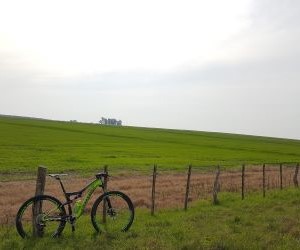Learn how to choose between clipless and flat pedals by comparing efficiency, control, comfort, and riding style to find the right setup for your needs.
WHAT SITUATIONAL ANGLES MATTER ON GRAVEL SECTORS IN STAGE RACES?
Gravel sectors in stage races add drama, unpredictability, and tactical complexity. Unlike smooth tarmac, gravel punishes mistakes in positioning, bike handling, and pacing. Riders who master the situational angles—wind direction, surface type, peloton dynamics, and fueling—can turn chaos into opportunity. This guide breaks down the critical factors that shape performance and strategy on gravel sectors, showing how to ride smarter when the race leaves the asphalt.

Positioning and peloton dynamics
Gravel sectors are notorious for splitting the peloton. Unlike wide roads, gravel often narrows, funnels riders, and magnifies positioning errors. Those who hit the front early avoid crashes, dust clouds, and unnecessary energy costs.
Why positioning is critical
Being in the first 20–30 riders drastically reduces the risk of being caught behind a crash or puncture. Gravel amplifies chaos; once gaps open, they are hard to close. Positioning before gravel sectors is like buying insurance—you might not always need it, but when things go wrong, it saves your race.
Stay near the front to react quickly to moves.
Anticipate pinch points where the road narrows.
Use teammates to shepherd you into prime position.
Drafting and group survival
Gravel increases rolling resistance, so drafting is even more valuable. Groups that cooperate survive, while isolated riders burn matches quickly. Smart sprinters and GC contenders alike understand that gravel is less about solo heroics and more about conserving energy in the right group.
Psychological warfare
Gravel isn’t just physical—it’s mental. Dust clouds obscure visibility, constant vibrations wear riders down, and crashes raise stress levels. Staying calm while others panic is itself a tactical advantage. Riders who project confidence often deter rivals from attacking recklessly.
Terrain, wind, and equipment choices
Not all gravel is created equal. The situational angles depend heavily on terrain type, wind direction, and gear setup. Success lies in balancing speed, control, and risk management.
Reading the gravel surface
Loose gravel, packed dirt, and chunky stones each demand different handling. Riders who scan ahead can pick smoother lines and avoid energy-sapping surfaces. Tire choice—28–32mm with tubeless setups—provides grip without sacrificing too much speed. Pressure adjustments of just 5 psi can decide whether you float or sink on rough sections.
Loose gravel: lower pressure for grip.
Hard-packed dirt: maintain speed with higher pressure.
Mixed terrain: versatile all-round tire setup is best.
Wind as a decisive factor
Crosswinds on gravel intensify echelons and make positioning even harder. Riders caught at the back suffer doubly: they fight both wind and terrain. Strong teams exploit these conditions by drilling the pace in front, shredding the field behind them. Anticipating wind angles is therefore as important as tire choice.
Mechanical risk management
Punctures and mechanicals are common. Carrying spare tubes, CO2, and knowing how to perform quick roadside fixes can salvage a race. Teams often place support vehicles strategically before long gravel sectors. Solo riders should plan contingencies and never gamble on “hoping for the best.”
Fueling, pacing, and tactical timing
Gravel riding burns more energy than smooth tarmac. Constant micro-adjustments, vibrations, and resistance sap glycogen faster. Riders who underestimate fueling or misjudge pacing often crack before the decisive moments.
Fueling for high-stress sectors
Eat before gravel sectors, because once inside, it’s harder to grab food safely. Liquid calories and gels are easier to manage than bars when bouncing over rocks. Aim for 60–90g of carbs per hour, with hydration adapted to heat and dust exposure.
Pre-load with carbs before key sectors.
Use bottles with secure cages—gravel rattles them loose.
Keep emergency gels in pockets for late-race bonks.
Pacing under pressure
Gravel tempts riders to burn too many matches early. Smart pacing means holding back slightly, trusting that chaos will claim over-eager rivals. Riders who conserve watts often roll past rivals who cracked halfway through. Think of gravel like a stock market crash—patience outperforms reckless spending.
When to attack—and when to survive
The best attacks on gravel happen right after technical sections, when rivals are still recovering or fixing lines. Conversely, if survival is the goal, the focus should be on smooth riding, staying in groups, and avoiding unnecessary risks. Knowing whether you are the aggressor or survivor defines your tactical choices.
In the end, gravel sectors in stage races are high-risk, high-reward arenas. Riders who analyze situational angles—positioning, terrain, wind, fueling, and tactics—gain control in an otherwise chaotic battlefield. Gravel doesn’t just test legs; it tests judgment, resilience, and adaptability. Those who master these dynamics turn unpredictable roads into podium opportunities.
YOU MAY ALSO BE INTERESTED






